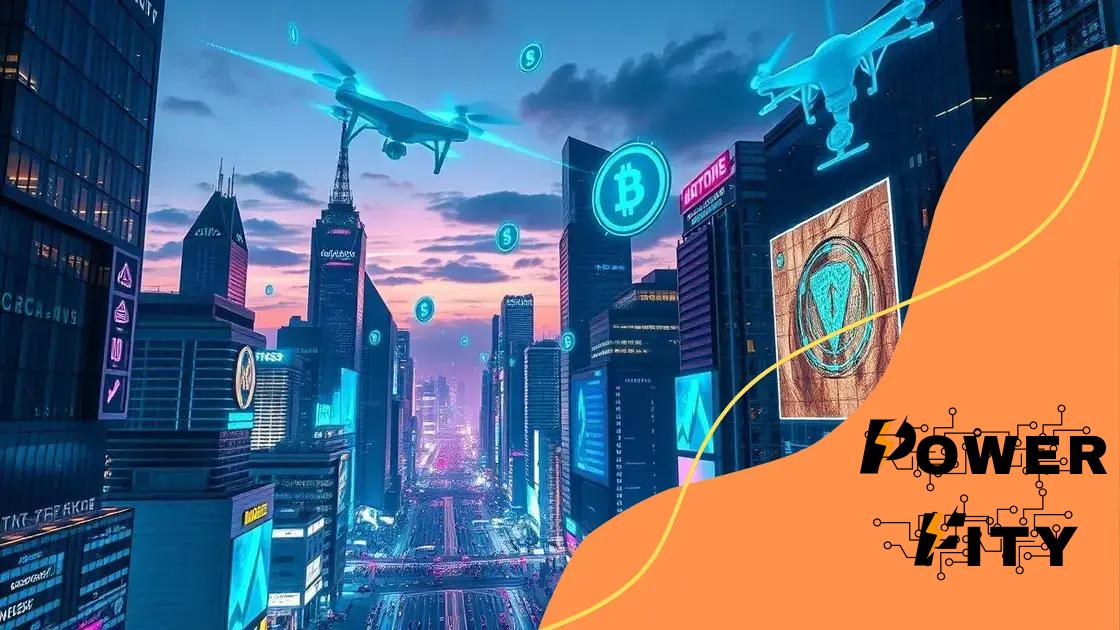DeFi and its role in disrupting traditional banking

DeFi, or decentralized finance, disrupts traditional banking by providing accessible, low-cost financial services through blockchain technology, enabling users to lend, borrow, and trade without intermediaries while facing risks such as smart contract vulnerabilities and market volatility.
DeFi and its role in disrupting traditional banking is reshaping our understanding of financial systems. Have you ever wondered how decentralized finance can empower you? Let’s dive into this revolution.
Understanding DeFi and its core principles
Understanding DeFi and its core principles is crucial in our fast-evolving financial landscape. At its core, decentralized finance, or DeFi, aims to recreate traditional financial systems using blockchain technology. This means that financial services become accessible without the need for a central authority.
One of the main principles of DeFi is decentralization, which allows users to have control over their assets. This contrasts sharply with traditional banking, where financial institutions manage client funds. DeFi provides opportunities for anyone with internet access to engage in financial activities.
Key Components of DeFi
Several fundamental elements make up the DeFi ecosystem:
- Smart Contracts: These automatically execute transactions based on predefined conditions, promoting transparency and trust.
- Blockchain Technology: It provides the secure foundation for DeFi, ensuring transactions are tamper-proof.
- Decentralized Applications (dApps): Built on blockchains, they allow users to interact directly with protocols.
Another significant aspect of DeFi is protocol interoperability. It enables different DeFi platforms to communicate with each other, creating a comprehensive ecosystem where users can transfer assets freely. This connectivity enhances user experience and provides broader access to financial services.
Moreover, DeFi introduces the concept of yield farming, where users can earn rewards by providing liquidity to various platforms. This is a transformative shift from traditional savings accounts with minimal interest rates.
Risks and Considerations
With great opportunities come challenges. One must consider the risks associated with DeFi, such as smart contract vulnerabilities and market volatility. It’s essential to conduct thorough research before engaging in any DeFi activities.
How DeFi challenges traditional banking models
How DeFi challenges traditional banking models is a significant topic in the evolving financial landscape. As decentralized finance (DeFi) grows, it offers alternatives that contradict conventional banking methods, often providing more efficient and accessible solutions for users.
One primary way DeFi challenges traditional banking is through its low-cost transactions. In contrast to banks, which impose various fees, DeFi platforms minimize costs, making financial services affordable. This enables users to transfer value globally without the financial burdens often associated with banks.
Accessibility and Inclusion
Additionally, DeFi promotes greater financial inclusion. Many individuals worldwide lack access to traditional banking services. DeFi allows anyone with an internet connection to participate in financial activities, which is a game changer for the unbanked or underbanked populations.
- Elimination of Central Authority: Users control their funds without needing a bank, creating a more egalitarian approach.
- Open-Source Technology: Most DeFi protocols are open for public use, encouraging innovation and competition.
- Peer-to-Peer Transactions: Users can transact directly with one another, reducing reliance on intermediaries.
Moreover, the use of smart contracts allows for automated transactions, eliminating human error and enhancing efficiency. This technology reduces the risks of fraud and increases trust among users, which traditional banks often struggle to achieve.
Risks and Challenges
Despite its advantages, DeFi also faces challenges that impact its ability to fully replace traditional banking. Risks such as market volatility and smart contract vulnerabilities can deter potential users. Understanding these risks is crucial for anyone interested in engaging with DeFi.
As DeFi continues to evolve, it will likely further disrupt traditional banking models, offering alternatives that prioritize efficiency, accessibility, and user empowerment.
Key benefits of DeFi for consumers

Key benefits of DeFi for consumers highlight how decentralized finance transforms the financial landscape. DeFi offers numerous advantages that can significantly enhance the user experience in managing personal finances and participating in the economy.
One of the greatest benefits is financial accessibility. Unlike traditional banks, which may require extensive documentation and minimum balances, DeFi platforms allow anyone with an internet connection to access a variety of financial services. This inclusivity empowers people in underserved areas to engage in financial activities.
Lower Costs and Fees
DeFi also provides the potential for lower transaction fees. Traditional banks often impose high fees for international transactions, account maintenance, and other services. In DeFi, users can transact with significantly reduced fees, allowing them to save money while transferring or earning funds.
- Elimination of Middlemen: DeFi removes the need for intermediaries, directly connecting users with financial services.
- Yield Farming Opportunities: Users can earn interest on their assets by participating in liquidity pools, sometimes receiving higher returns than traditional savings accounts.
- Greater Control Over Assets: Consumers maintain ownership and control of their funds, minimizing risks associated with bank insolvency.
Additionally, DeFi promotes a higher degree of transparency. All transactions are recorded on the blockchain, providing users with access to verifiable data regarding their financial activities. This level of transparency fosters trust between users and the platforms they use.
Innovative Financial Products
Consumers can also benefit from innovative financial products that develop within the DeFi space. For instance, decentralized lending allows users to borrow assets without the traditional credit checks, making loans more accessible. Furthermore, derivatives and synthetic assets enable users to leverage investments in unique ways.
As the DeFi ecosystem continues to flourish, it becomes crucial for consumers to understand and take advantage of these benefits. By engaging with DeFi, users can experience a financial landscape that is more equitable, affordable, and innovative.
Real-world examples of DeFi applications
Real-world examples of DeFi applications showcase the practical impact of decentralized finance in today’s economy. Various platforms and protocols have emerged, demonstrating how DeFi can offer innovative solutions for financial services.
One notable example is Aave, a decentralized lending protocol. Users can lend their cryptocurrency to earn interest or borrow assets without the need for traditional credit checks. Aave offers flexibility, allowing users to choose between fixed and variable interest rates.
Compound Finance
Another prominent platform, Compound Finance, enables users to earn interest on their crypto assets by contributing them to a shared pool. The more liquidity participants provide, the more they earn. This system allows users to maintain control of their funds while putting them to work.
- Liquidity Protocols: Many users leverage protocols like Uniswap to swap tokens directly without intermediaries.
- Insurance Platforms: Projects like Nexus Mutual allow users to purchase insurance for their smart contracts, providing protection against failures.
- Yield Farming: Users can participate in yield farming through platforms like Yearn.finance, where their funds are allocated automatically to maximize returns.
Additionally, SushiSwap has gained popularity as a community-driven decentralized exchange, where users can trade tokens and earn rewards through liquidity provision. This highlights how DeFi platforms empower users to take an active role in their financial well-being.
Real-World Impact
These examples illustrate that DeFi is not just theoretical; it has practical applications that are reshaping the financial landscape. From providing loans and facilitating trades to offering insurance and generating income, DeFi is finding its place in everyday financial activities.
As more users engage with these platforms, the adoption of DeFi will continue to grow, offering innovative alternatives to conventional financial systems.
Challenges and risks associated with DeFi
Challenges and risks associated with DeFi are critical to consider as this innovative financial landscape continues to evolve. While DeFi offers exciting opportunities, it also presents unique vulnerabilities and challenges that users must understand.
One major risk is smart contract vulnerabilities. These self-executing contracts are the backbone of many DeFi platforms. If a smart contract has a coding error or a vulnerability, it can be exploited by malicious actors, leading to significant financial losses for users. Thus, thorough auditing and testing of these contracts are essential.
Market Volatility
Another challenge is market volatility. Cryptocurrencies can experience extreme price fluctuations. For example, a sudden drop in the value of a token can affect collateralized loans on DeFi platforms. Users need to be aware of the inherent risks when engaging with assets that may rapidly change in value.
- Lack of Regulation: DeFi operates largely outside traditional regulatory frameworks, which can expose users to fraud and loss without the protections found in traditional finance.
- Liquidity Risks: Some DeFi platforms may struggle with liquidity, leading to challenges when users try to withdraw their assets.
- Scams and Fraud: As DeFi grows, so does the risk of scams, including phishing attacks and fraudulent projects that exploit uninformed users.
Additionally, poor user education can lead to mistakes. Many users entering the DeFi space may not fully understand how these systems work. This lack of knowledge can result in unintended financial harm. It’s vital for users to conduct thorough research and familiarize themselves with the risks before engaging with DeFi protocols.
Security Concerns
Security concerns are another aspect of DeFi risks. Decentralized platforms can be susceptible to hacks that compromise user funds. For instance, decentralized exchanges (DEXs) are exciting but can be appealing targets for hackers. Enhancing security practices and using reputable platforms can help mitigate these risks.
Recognizing these challenges ensures that users remain informed and cautious while navigating the DeFi landscape. As the space matures, ongoing vigilance will be crucial for both investors and developers alike.
FAQ – Frequently Asked Questions about Decentralized Finance (DeFi)
What is DeFi and how does it differ from traditional finance?
DeFi, or decentralized finance, refers to financial systems built on blockchain technology that operate without intermediaries, unlike traditional finance where banks and institutions manage transactions.
What are the main benefits of using DeFi platforms?
DeFi platforms offer benefits such as lower transaction fees, increased accessibility for users globally, and innovative financial products like lending and yield farming.
What are the risks associated with DeFi?
Risks include smart contract vulnerabilities, market volatility, potential scams, and a lack of regulatory oversight, making user education vital.
How can I safely participate in DeFi?
To safely participate in DeFi, always conduct thorough research, use reputable platforms, and understand the risks involved with the protocols you interact with.





